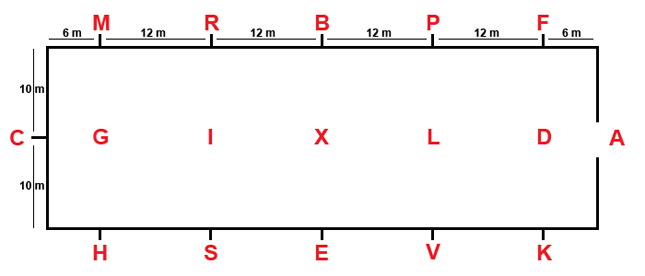Riding Accurately in a Dressage Arena
When you are competing in the dressage arena, at any level, there are set movements that you and your horse must complete. These may include circles, half circles, serpentines or diagonals and they are usually performed at set points around an arena. But how do you ride a 20 metre circle in a rectangle arena? By using the letters around the arena as well as their placement, it can make it easier to ride an accurate circle or serpentine.
A standard dressage arena is measured at 60 metres by 20 metres. The letters A and C, which mark the ends of the centreline, are placed 10 metres in from each long side, with an entry gate at A and the judge located at C. The four corner letters are placed 6 metres down the long sides of the arena from each end. Each letter between them is placed 12 metres apart down the long side. A handy phrase to help you remember the location of the main letters is All King Edward’s Horses Can Make Bay Foals. Then simply add the secondary markers R,S,V and P to the middle of each of those to make the arena as shown below.

Now that we know where the letters are located and the distances between them, it can make it easier to ride a circle of any size in the arena.
- A 20m circle starting at A or C is going to touch both sides of the arena, 4m past the corner markers, and cross the centreline 2m beyond the secondary markers.
- A 20m circle starting at B or E is going to cross the centreline 2m inside each of the secondary markers and touch the long side at the opposite marker.
- A 15m circle starting on the long side is going to hit the quarterline (halfway between the long side of the arena and the centreline) on the far side from where you begin.
- A 10m circle starting on the long side is going to hit the centreline, before returning back to the long side.
- A 3-loop serpentine is going to cross the centreline at the same points as a circle at A or C, but changing direction of the circle each time you cross the centreline.
It is important to use the corners of your arena to make sure your horse is in balance, that they are listening to your aids and are prepared to tackle whatever movement is next. As you are the only one who has learnt the test and knows the order and location of each movement, it is up to you to make sure your horse is prepared for each movement before it is meant to happen. An accurate test will go a long way towards impressing any judge!
Written by Emma H.
Experts in Equine Nutrition
Every product in the Ranvet range has been developed to meet a horse’s most specific need at any given time, be it in a training environment or on a breeding farm. Having pioneered the formulation of specific medications and dietary supplements for horses, the company is now recognised as a leader in the areas of equine health and nutrition.
